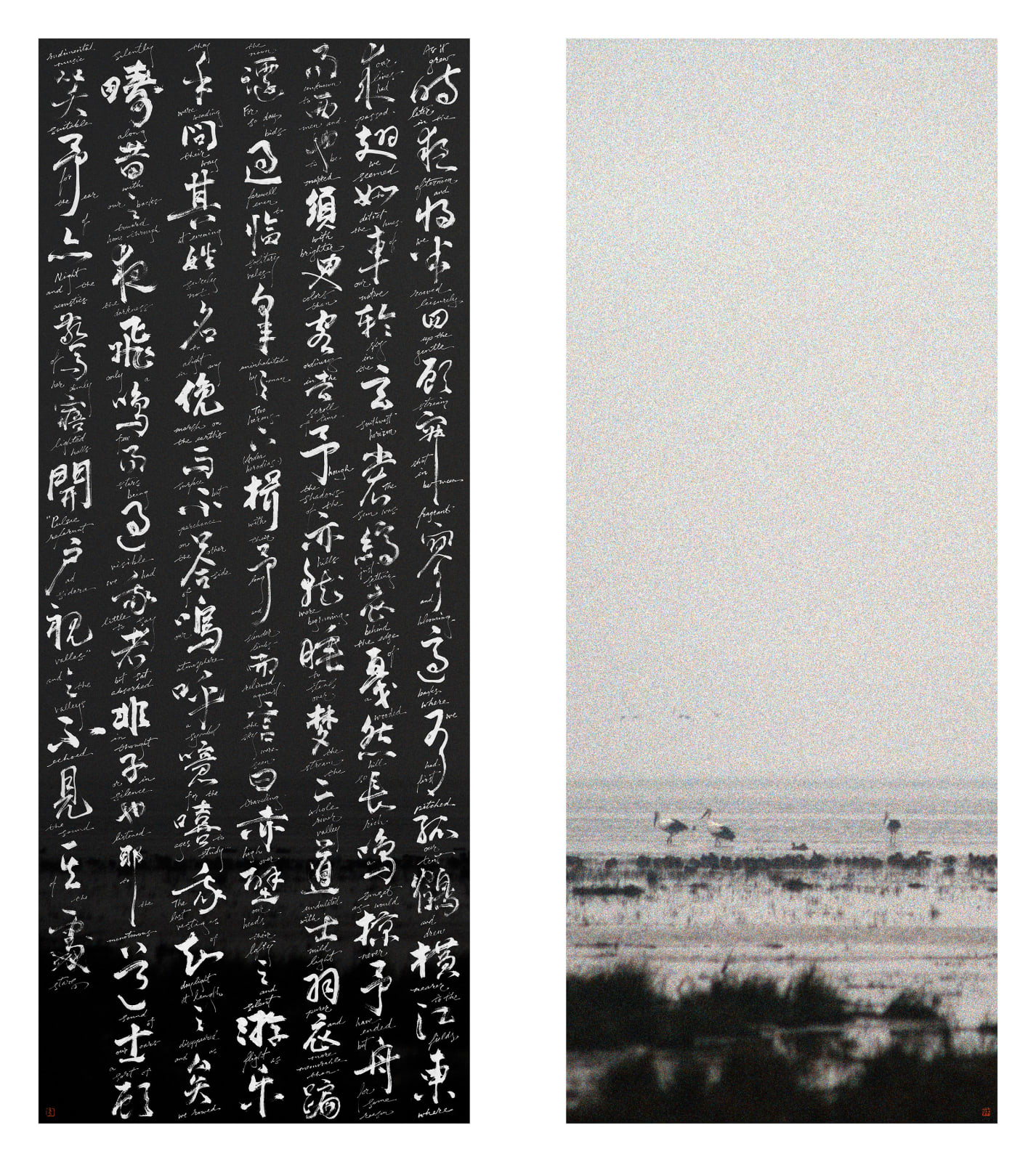-
Artworks

Michael Cherney American, b. 1969
Su-Thoreau 蘇-梭羅 , 2025Photography and bilingual calligraphy, ink on Mitsumata paper 摄影,双语书法 纸本55 1/2 x 49 in
141 x 124.5 cm
mounted dimensions: 84 1/4 x 53 in (214 x 134.6 cm)Copyright The ArtistMichael Cherney's latest series, Within the Gate《其間》, aims to create bilingual art for individuals inhabiting or navigating between cultures. Translating poetry across diverse cultural backgrounds, requiring more than literal translation,...Michael Cherney's latest series, Within the Gate《其間》, aims to create bilingual art for individuals inhabiting or navigating between cultures. Translating poetry across diverse cultural backgrounds, requiring more than literal translation, presents distinct challenges. As a bilingual artist, Cherney's focus is on preserving the poem's rhythm and essence, adapting certain elements to resonate within a new cultural milieu. Through this artistic reinterpretation in calligraphic form, the poetry's beauty transcends linguistic barriers, extending an invitation to a broader, more diverse audience to delve into its depth and resonance. Simultaneously, it provokes contemplation on fostering bridges of mutual understanding and dialogue amidst today's increasingly fragmented cultural landscape.
In his latest piece, Su-Thoreau captures the tranquil majesty of the Poyang Lake, where language and landscape intertwine in a poetic dialogue. Unlike earlier works in the series, which feature a single bilingual text, this composition presents two complete texts—Su Shi’s classical Chinese poetry and Thoreau’s English prose—woven together in a seamless interplay of tradition and interpretation. Each viewer can fully engage with at least one text, while bilingual readers experience the subtle echoes and resonances between them.
Cherney’s calligraphy does more than inscribe meaning; it breathes across the darkened water’s surface, where strokes merge, overlap, and converse. The vertical scrolls recall the gravitas of ancient steles, their presence imbued with the weight of history. A photograph bridges the two scrolls, dissolving the boundary between them. Instead of choosing an image of birds soaring over a boat—a natural metaphor for passage—Cherney depicts them at rest, as if the journey has already been written into the fabric of the scene, while distant silhouettes linger like whispers of movement.
At the intersection of text, image, and calligraphy, Cherney expands the concept of bilingualism beyond linguistics, demonstrating its harmony within artistic expression. By weaving poetry in two languages into a unified calligraphic form, he bridges Eastern and Western traditions, preserving the rhythm of poetry while reinterpreting it within a modern cultural context.
秋麦(Michael Cherney)最新的系列作品《其间》旨在为中西跨文化之间穿梭的人们创造双语艺术的可能性。在不同文化背景下翻译诗歌面临着独特的挑战,需要超越字面翻译。作为一名双语艺术家,秋麦的重点是保留诗歌的节奏和精髓,调整某些元素以在新的文化环境中产生共鸣。通过这种书法形式的艺术重新诠释,诗歌的美超越了语言的障碍,向更广泛、更多样化的观众发出邀请,深入探索其深度和共鸣。同时,它引发了对如何在当今日益分裂的文化环境中建立相互理解和对话桥梁的思考。
在秋麦的新作《苏-梭罗》(Su-Thoreau)中,他以镜头捕捉了鄱阳湖的静谧与壮阔,湖光山色间,两首诗文如流水般自然流淌,与眼前的景致交相辉映。这两段文字,皆是对江河湖海的描绘,仿佛早已与这片水域融为一体,诗意与景致在此悄然共鸣。
与系列中的其他作品不同,这幅作品中,秋麦选择将两段完整的文本并置呈现。苏轼的诗与梭罗的散文,一东一西,一古一今,在书法的笔触下相互映照,传统与诠释在无声中交织。无论是熟悉中文还是英文的观众,都能沉浸于至少一段文字之中,感受其中的意境;而通晓双语的观者,则能更深刻地体味到两者之间微妙的呼应,仿佛听见了跨越时空的低语。
秋麦将半幅水景的影调加深,原本以黑墨写成的书法被倒置,卷轴的形式让人联想到古代碑刻拓印的庄重,仿佛历史的沉积在此刻被唤醒。他没有选择直观展现飞鸟掠过舟楫的画面,而是定格了水鸟沿岸静栖的景象。这一瞬间,仿佛文本中的故事已然展开,如同话剧开场,主角悄然就位,留给观者无限的想象与期待。
在这幅作品中,Michael Cherney将双语的概念拓展至语言学之外,展现了书法艺术中的和谐之美。共享的笔画如同架起的桥梁,连接了东西方的传统,既保留了诗歌的韵律,又在现代文化的语境中赋予了它新的生命。书法与摄影的交融,不仅是对文字的诠释,更是一场跨越时空的对话,让观者在静谧的湖光山色中,感受到诗意与艺术的永恒魅力。Original English Text
As it grew later in the afternoon, and we rowed leisurely up the gentle stream, shut in between fragrant and blooming banks, where we had first pitched our tent, and drew nearer to the fields where our lives had passed, we seemed to detect the hues of our native sky in the southwest horizon. The sun was just setting behind the edge of a wooded hill, so rich a sunset as would never have ended but for some reason unknown to men, and to be marked with brighter colors than ordinary in the scroll of time. Though the shadows of the hills were beginning to steal over the stream, the whole river valley undulated with mild light, purer and more memorable than the noon. For so day bids farewell even to solitary vales uninhabited by man. Two herons (Ardea herodias), with their long and slender limbs relieved against the sky, were seen traveling high over our heads, — their lofty and silent flight, as they were wending their way at evening, surely not to alight in any marsh on the earth’s surface, but, perchance, on the other side of our atmosphere, a symbol for the ages to study.... The last vestiges of daylight at length disappeared, and as we rowed silently along with our backs toward home through the darkness, only a few stars being visible, we had little to say, but sat absorbed in thought, or in silence listened to the monotonous sound of our oars, a sort of rudimental music, suitable for the ear of Night and the acoustics of her dimly lighted halls; “Pulsae referunt ad sidera valles,” and the valleys echoed the sound of the stars.
Henry David Thoreau, from A Week on the Concord and Merrimack Rivers
Chinese translation of the original English text
天色渐晚,我们行驶在和缓的溪流上,悠闲地溯河而上。小河两岸鲜花怒放,芳香四溢,我们的第一个宿营地就是在这个河岸上。小船慢慢地驶近我们生活过的田野,我们似乎看到了西南方地平线上的家乡上空的云彩。太阳刚刚躲进一座树木繁茂的小山后面,夕阳的余晖如此绚烂,仿佛它永远都将放射光芒,除非有不为人知的原因它才会消亡,而且在时间的卷轴上,它将被标上更加艳丽的色彩。整个河面渐渐被群山的阴影所覆盖,在柔和的光线下泛起涟漪,这柔光比月色还要恬静宜人。白昼似乎在向孤寂的杳无人迹的山谷道别。两只苍鹭张开长而纤细的翅膀,高高地飞过我们头顶上空——它们高傲而无声地飞翔着,像是在天黑之前赶路回家:无疑,它们不会落在大地上的沼泽中,但或许,会落在天空的另一边。它们都将是人们世代研究的象征之物。… 最后一道日光的痕迹最终消失了,天空中几颗稀落的星星依稀可见,我们在夜幕中朝着家乡的方向静静地划船,沉默不语,或是沉浸在思索之中,或是静静地听着单调的划桨声——这是一种浅显的音乐,只与黑夜的耳朵和她灯光昏暗的大厅中的声音相配。“Pulsae referunt ad sidera valles,” 山谷的回声还在星空中飘荡。
亨利·戴维·梭罗,《河上一周》节录
original Chinese text
時夜將半,四顧寂寥。適有孤鶴,橫江東來。翅如車輪,玄裳縞衣,戛然長鳴,掠予舟而西也。須臾客去,予亦就睡。夢二道士,羽衣蹁躚,過臨皋之下,揖予而言曰:“赤壁之游樂乎?”問其姓名,俛而不答。“嗚呼!噫嘻!我知之矣。疇昔之夜,飛鳴而過我者,非子也耶?”道士顧笑,予亦驚寤。開戶視之,不見其處。
蘇軾 ,《后赤壁賦》節錄
English translation of the original Chinese text
By then it was toward midnight. All around us it was deathly silent. Suddenly, a solitary crane came toward us across the river from the east. Its wings traced cartwheels in the air. It seemed dressed in a white blanket over a black gown, and let out a long piercing cry — “jia” — as it swept past our boat and headed west. A short while later the guests left, and I fell asleep. I dreamed of two Daoists clothed in feathers, fluttering about. As they passed by Lingao, they greeted me and asked, “Did you enjoy your journey to Red Cliff?” When I asked their names, they looked down without answering. “Oh! Now I understand! Last night, was it not you who called out as you flew by?” The Taoists looked back at me and laughed. And then I suddenly awakened. I opened the door and looked outside but saw no trace of them.
Su Shi, from Latter Ode to Red Cliff
Exhibitions
2025 Mar 13th - May 3rd "Fluid Strength: The Art of Ink" Fu Qiumeng Fine Art, New York, NY
2025, Light & Grain:秋麦, Fu Qiumeng Fine Art, New York, NY.
Join our mailing list
* denotes required fields
We will process the personal data you have supplied to communicate with you in accordance with our Privacy Policy. You can unsubscribe or change your preferences at any time by clicking the link in our emails.

